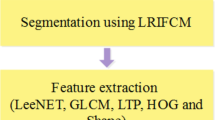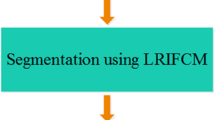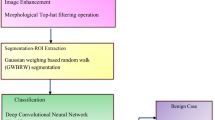Abstract
In adults, Brain Tumor (BT) is the deadliest disease. Thus, in the treatment of BTs, accurate detection and classification are essential. Many approaches are developed, but these previous approaches still have defects in accuracy and reliability and they only predict the tumor or tumor localization. So, a cumulative density function based bi-directional long short term memory network (CDF-BiLSTM) centered BT classification and severity level prediction is proposed. Primarily, by employing Suppressed Sobel Operator-Covariance Speckle Reducing Anisotropic Diffusion (SSO-CSRAD) techniques, noise in the input MRI image was removed. Next, by deploying Neighbourhood Function-based Texton Map Generation (NF-TMG) techniques, the tumor location was detected. Then, the tumor was segmented by using Gradient Operator-based Balloon Snake (GO-BS). Afterward, the features are extracted; also, the optimal features are selected by deploying Secant Wild Geese Migration Optimization (SWGMO). Then, the type of tumor was detected by utilizing CDF-BiLSTM. In the end, for each class, the severity prediction was determined. The experimental analysis was done, where the proposed model’s efficiency is depicted.









Similar content being viewed by others
Availability of data and materials
Not applicable.
Code availability
Not applicable.
References
Abdelaziz Ismael, S.A., Mohammed, A., Hefny, H.: An enhanced deep learning approach for brain cancer MRI images classification using residual networks. Artif. Intell. Med. 102, 1–14 (2020). https://doi.org/10.1016/j.artmed.2019.101779
Ahuja, S., Panigrahi, B.K., Gandhi, T.K.: Enhanced performance of Dark-Nets for brain tumor classification and segmentation using colormap-based superpixel techniques. Mach. Learn. Appl. 7, 1–13 (2022). https://doi.org/10.1016/j.mlwa.2021.100212
Arabahmadi, M., Farahbakhsh, R., Rezazadeh, J.: Deep learning for smart healthcare—a survey on brain tumor detection from medical imaging. Sensors 22(5), 1–27 (2022). MDPI. https://doi.org/10.3390/s22051960
Ayadi, W., Elhamzi, W., Charfi, I., Atri, M.: Deep CNN for brain tumor classification. Neural. Process. Lett. 53(1), 671–700 (2021). https://doi.org/10.1007/s11063-020-10398-2
Chattopadhyay, A., Maitra, M.: MRI-based brain tumour image detection using CNN based deep learning method. Neurosci. Informat. 2(4), 1–6 (2022). https://doi.org/10.1016/j.neuri.2022.100060
Gunasekara, S.R., Kaldera, H.N.T.K., Dissanayake, M.B.: A systematic approach for MRI brain tumor localization and segmentation using deep learning and active contouring. J. Healthc. Eng. (2021). https://doi.org/10.1155/2021/6695108
Isunuri, B.V., Kakarla, J.: Three-class brain tumor classification from magnetic resonance images using separable convolution based neural network. Concurr. Comput.: Pract. Exp. 34(1), 1–9 (2022). https://doi.org/10.1002/cpe.6541
Karayegen, G., Aksahin, M.F.: Brain tumor prediction on MR images with semantic segmentation by using deep learning network and 3D imaging of tumor region. Biomed. Signal Process. Control 66, 1–14 (2021). https://doi.org/10.1016/j.bspc.2021.102458
Khan, A.R., Khan, S., Harouni, M., Abbasi, R., Iqbal, S., Mehmood, Z.: Brain tumor segmentation using K-means clustering and deep learning with synthetic data augmentation for classification. Microsc. Res. Tech. 84(7), 1389–1399 (2021). https://doi.org/10.1002/jemt.23694
Li, S., Liu, J., Song, Z.: Brain tumor segmentation based on region of interest-aided localization and segmentation U-Net. Int. J. Mach. Learn. Cybern. 13(9), 2435–2445 (2022). https://doi.org/10.1007/s13042-022-01536-4
Maqsood, S., Damaševičius, R., Maskeliūnas, R.: Multi-modal brain tumor detection using deep neural network and multiclass SVM. Medicina (lithuania) 58(8), 1–19 (2022). https://doi.org/10.3390/medicina58081090
Nayak, D.R., Padhy, N., Mallick, P.K., Bagal, D.K., Kumar, S.: Brain tumour classification using noble deep learning approach with parametric optimization through metaheuristics approaches. Computers 11(1), 1–14 (2022). https://doi.org/10.3390/computers11010010
Raza, A., Ayub, H., Khan, J.A., Ahmad, I., Salama, A.S., Daradkeh, Y.I., Javeed, D., Rehman, A.U., Hamam, H.: A hybrid deep learning-based approach for brain tumor classification. Electronics (switzerland) 11(7), 1–17 (2022). https://doi.org/10.3390/electronics11071146
Rinesh, S., Maheswari, K., Arthi, B., Sherubha, P., Vijay, A., Sridhar, S., Rajendran, T., Waji, Y.A.: Investigations on brain tumor classification using hybrid machine learning algorithms. J. Healthc. Eng. 2022, 1–9 (2022). https://doi.org/10.1155/2022/2761847
Shah, H.A., Saeed, F., Yun, S., Park, J.H., Paul, A., Kang, J.M.: A robust approach for brain tumor detection in magnetic resonance images using finetuned efficientNet. IEEE Access 10, 65426–65438 (2022). https://doi.org/10.1109/ACCESS.2022.3184113
Srinivas, C., Nandini, N.P., Zakariah, M., Alothaibi, Y.A., Shaukat, K., Partibane, B., Awal, H.: Deep transfer learning approaches in performance analysis of brain tumor classification using MRI images. J. Healthc. Eng. (2022). https://doi.org/10.1155/2022/3264367
Tiwari, P., Pant, B., Elarabawy, M.M., Abd-Elnaby, M., Mohd, N., Dhiman, G., Sharma, S.: CNN based multiclass brain tumor detection using medical imaging. Comput. Intell. Neurosci. (2022). https://doi.org/10.1155/2022/1830010
Ullah, N., Khan, J.A., Khan, M.S., Khan, W., Hassan, I., Obayya, M., Negm, N., Salama, A.S.: An effective approach to detect and identify brain tumors using transfer learning. Appl. Sci. 12(11), 1–17 (2022). https://doi.org/10.3390/app12115645
Vankdothu, R., Hameed, M.A.: Brain tumor MRI images identification and classification based on the recurrent convolutional neural network. Meas: Sens 24, 1–11 (2022). https://doi.org/10.1016/j.measen.2022.100412
Wu, W., Li, D., Du, J., Gao, X., Gu, W., Zhao, F., Feng, X., Yan, H.: An intelligent diagnosis method of brain MRI tumor segmentation using deep convolutional neural network and SVM algorithm. Comput. Math. Methods Med. (2020). https://doi.org/10.1155/2020/6789306
Funding
The authors did not receive financial support from any organization for the submitted work.
Author information
Authors and Affiliations
Contributions
Not applicable.
Corresponding author
Ethics declarations
Conflicts of interest
The authors declare that they have no known competing financial interests or personal relationships that could have appeared to influence the work reported in this paper.
Consent to participate
Not applicable.
Consent for publication
Authors give consent to the Journal to publish their article.
Additional information
Publisher's Note
Springer Nature remains neutral with regard to jurisdictional claims in published maps and institutional affiliations.
Rights and permissions
Springer Nature or its licensor (e.g. a society or other partner) holds exclusive rights to this article under a publishing agreement with the author(s) or other rightsholder(s); author self-archiving of the accepted manuscript version of this article is solely governed by the terms of such publishing agreement and applicable law.
About this article
Cite this article
Sakthi Prabha, R., Vadivel, M. Anticipating brain tumor classification and severity levels: employing the CDF-BILSTM model approach. Opt Quant Electron 56, 187 (2024). https://doi.org/10.1007/s11082-023-05760-2
Received:
Accepted:
Published:
DOI: https://doi.org/10.1007/s11082-023-05760-2




